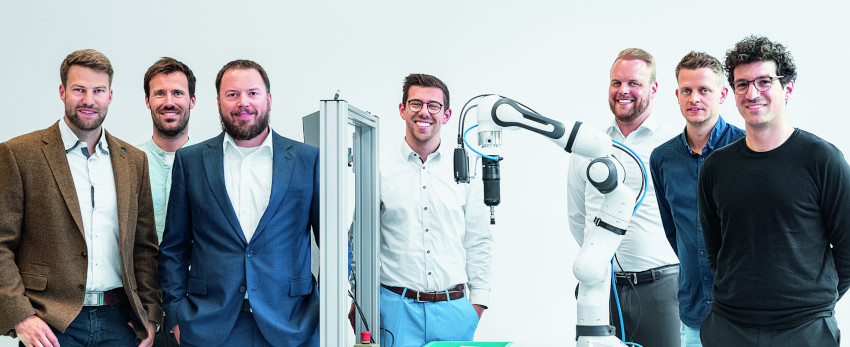
Distributed AI technique accelerates picking robot training
By DE Staff
Automation Machine BuildingFLAIROP research project successfully aggregates learned tasks from multiple robots without revealing sensitive training data.

Project FLAIROP’s research team: (from left) Kai Sandmann (Federal Ministry of Economics and Climate Protection), Maximilian Brock (DLR), Daniel Brauchle (Advanced Development Artificial Intelligence, Festo), Florian Leiser (Project Team KIT), Jan Seyler (Head of Advanced Development Analytics and Control, Festo), Sascha Rank (Project Manager KIT), Maximilian Gilles (Project Manager KIT).
(Photo credit: Festo)
Festo announced the successful conclusion of a research project aimed at making picking robots more intelligent using a distributed AI technique. Called FLAIROP (Federated Learning for Robot Picking), the project was a collaboration of researchers at Festo and the Karlsruhe Institute of Technology (KIT), as well as, Waterloo-based start-up Darwin AI and researchers at the University of Waterloo.
The crux of the research looked into how robots could learn from each other but without sharing proprietary training data. Called Federated Learning, the approach increases the speed at which AI-enabled robots can learn new tasks but without sharing sensitive company information.
Typically, the process of federated learning begins with a generic baseline machine learning model, a copy of which is distributed among various local robots (e.g. three pick-and-place robots at three different companies). As each robot uses the baseline model to learn a specific task, their generic models become unique.
Those changes are then contributed back to a central server where they are averaged together to create a new modified baseline model. That refined model is then redistributed to each robot, and so on, becoming increasingly diverse in its knowledge with each iteration. Since the baseline model is always an amalgamation of all the changes, it doesn’t retain or depend on any one contributor’s training data.
For the FLAIROP project, the research team set up five autonomous picking stations to train two robots at the KIT Institute for Materials Handling and Logistics Systems (IFL) in Karlsruhe, Germany and three at Festo’s operations in Esslingen, Germany.
Each cell was equipped with cameras to visually detect the items in front of them. Based on the camera image, each robot arm learned to recognize different items and select a suitable gripping method. With each iteration of the distributed model, each robot improved its grasping point detection, even for items it hadn’t previously be trained to recognize.
“We have developed a universal, simulation-based data set that we can use to train autonomous gripping robots in such a way that they are able to reliably grasp items that they have not seen before,” said Maximilian Gilles, research assistant at the KIT Institute for Materials Handling and Logistics Systems.
The implications of the project, the researchers say, could be far reaching. Take an automated bin picking cell in a manufacturing warehouse for example. Instead of isolated systems at different companies having to each learn how best to grasp hundreds or thousands of items individually, each of those systems could learn a fraction of the total items and share their generalized grasping dexterity with all the others.
www.festo.ca
www.ifl.kit.edu
https://darwinai.com
https://uwaterloo.ca
